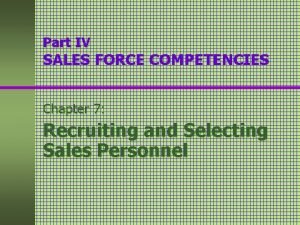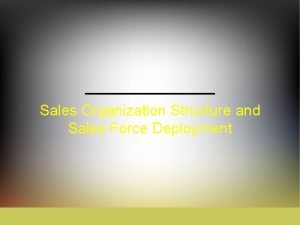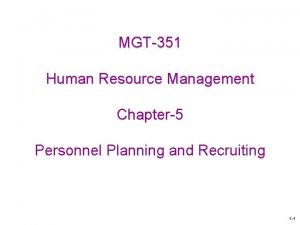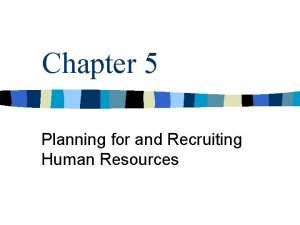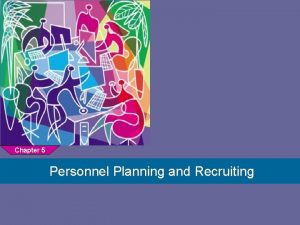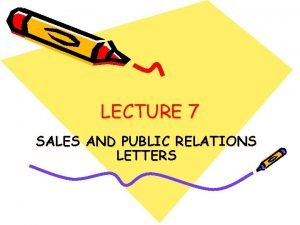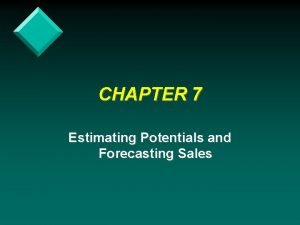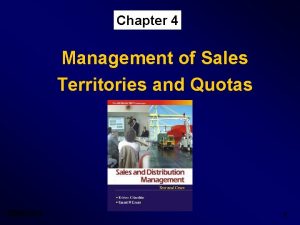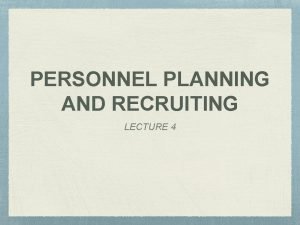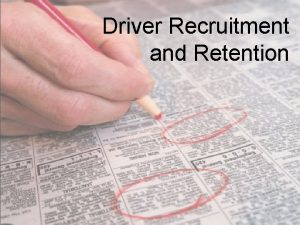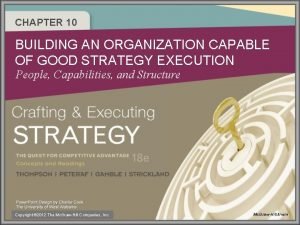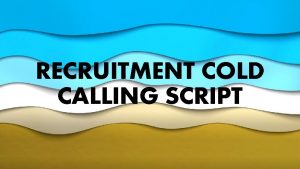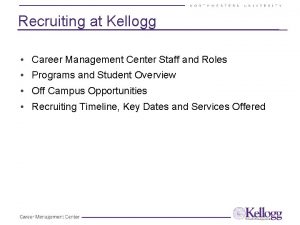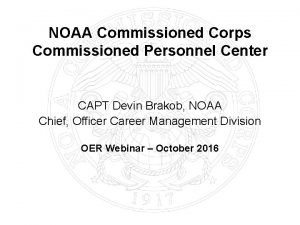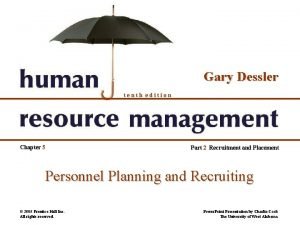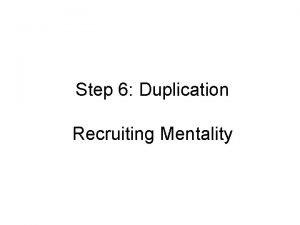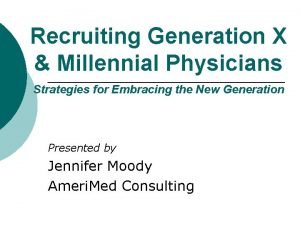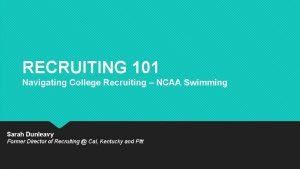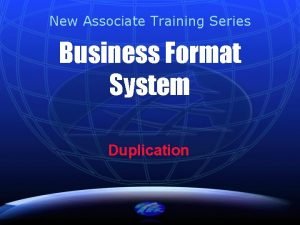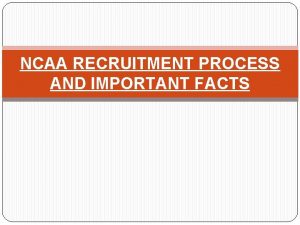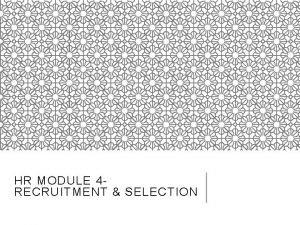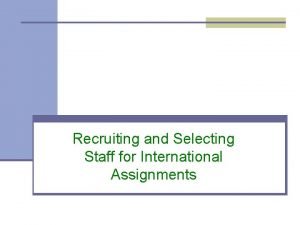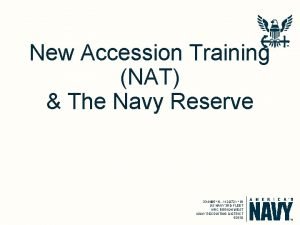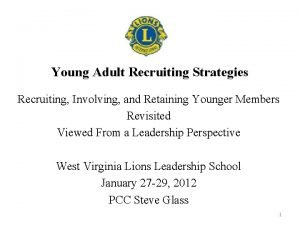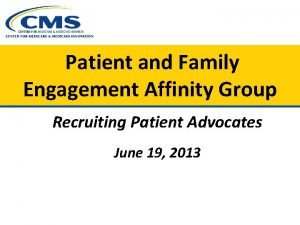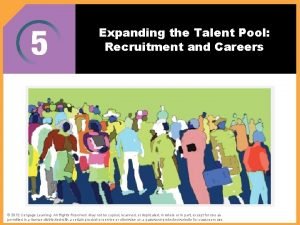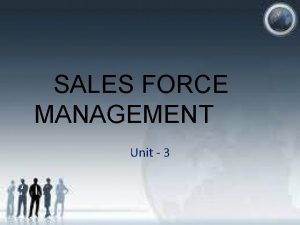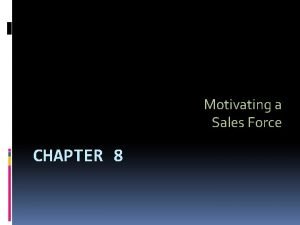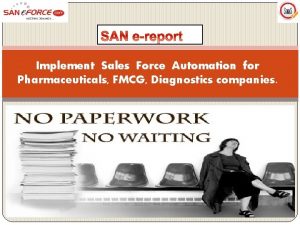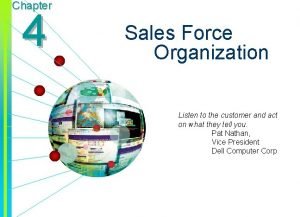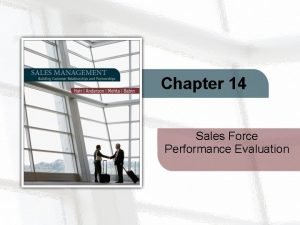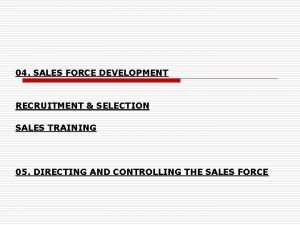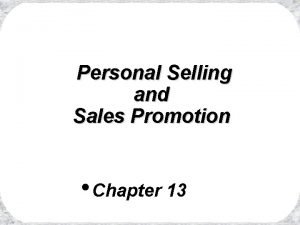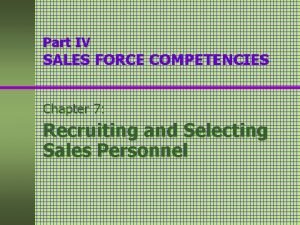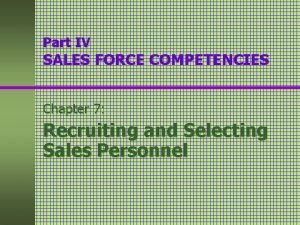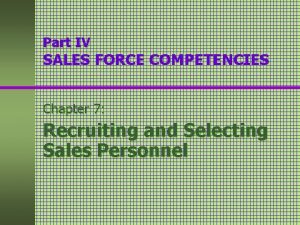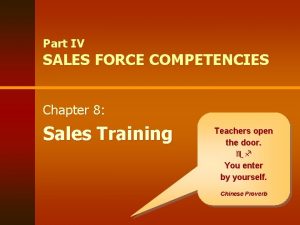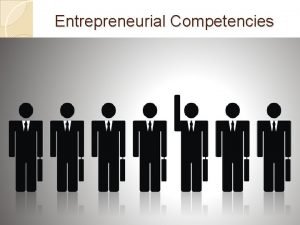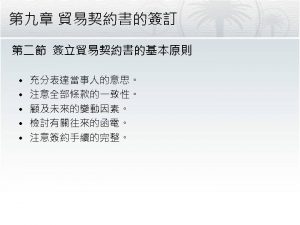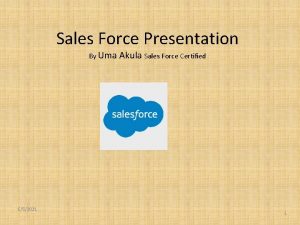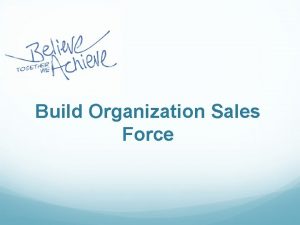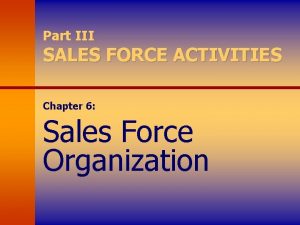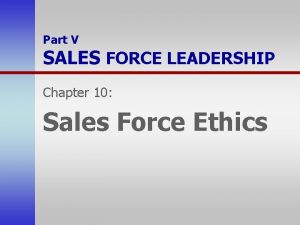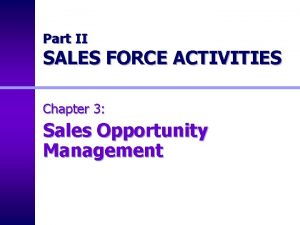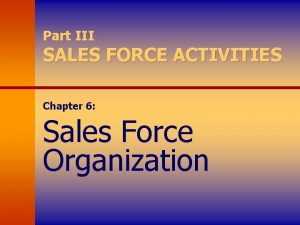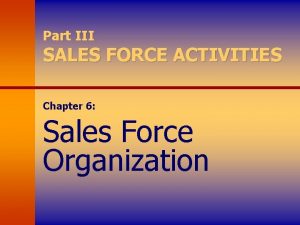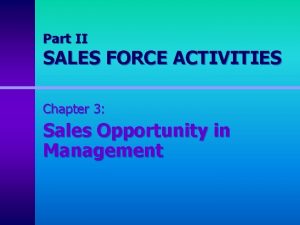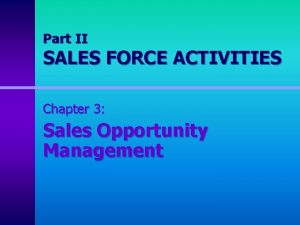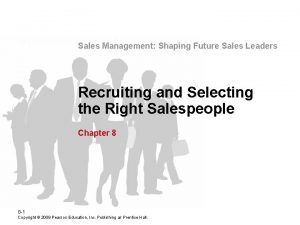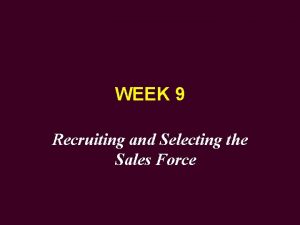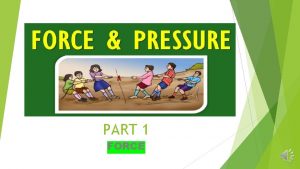Part IV SALES FORCE COMPETENCIES Chapter 7 Recruiting







































- Slides: 39

Part IV SALES FORCE COMPETENCIES Chapter 7: Recruiting and Selecting Sales Personnel

Chapter 7: Outline Recruitment And Selection Planning Recruit Candidates Select Prospects Validating the Process

Planning process n n The recruiting planning process should include a preliminary analysis of personnel needs , company culture , a job analysis , job description with the necessary job qualification. Proper planning will help ensure the success of the recruiting process and provide more time for locating the best candidates.

Planning process n n n n Personnel needs : The number of new salespeople needed will depend on several factors , including sales growth targets, distribution strategies , changes in sales force organization, and sales force turnover. Understanding the reasons for salesperson turnover is an important factor in assessing personnel needs. Turnover mean the rate at which salesperson leave jobs , which be calculated using : turnover rate = separation per year /average size of the sales force So if 30 people leave each year , and the size of the sales force is 150 , the turnover rate would be =30/150 = 20% This number is nothing as a number if we are not conducting a detailed analysis to know the truths behind such numbers , and this number should be compared to the other competitors , and to the industry average to know your real position.

Consumer 10% 12% Industrial 17% Services 66% 33% 78% 0 -10% 19% 50% 11 -16% 15% More than 16% Figure 7 -1: Sales Force Turnover Rates by Industry

Turnover Rates in Selected Industries Industry Construction Office Equipment Retail Wholesale (Consumer Goods) Electronics Business Services Pharmaceuticals Banking Real Estate Turnover Rates 13. 8% 47. 0 51. 2 18. 5 14. 1 26. 2 8. 3 4. 3 11. 9 Source: Dartnell’s 30 th Sales Force Compensation Survey (1999), p. 187.

Planning process n n n Company culture : In addition to the analysis of personnel needs , and other factors , a specific definition of the organization’s culture is necessary for the planning cycle validity. The process of connecting the company recruiting strategies to its core culture should help attract and retain higher performing salespeople , who fit with the company culture.

Planning process n n n Job analysis : Before managers can effectively recruit new salespeople , they must clearly understand the activities , tasks , responsibilities of their sales representatives. A job analysis is a systematic way to describe how a job is to be performed , as well as the tasks that make up the job. There a number of different procedures that can be used for performing job analysis , one of those method is the job analysis interview , or using questionnaires. Job analysis should focus on those critical success tasks high performing salespeople spend their time on , and compare those with low performing salesperson tasks.

Planning process n n n n Job description : information from the job analysis should be used to produce a job description, which is a written document that spells out the job relationship and requirements that characterize each sales position. A complete job description explains : 1) to whom the salesperson reports 2) how the salesperson interacts with other staff 3) the customers to be called on by the salesperson 4) the specific tasks to be carried out 5) the mental and physical demands of the job, 6) the types of the product to be sold.

Planning process n n n Job qualification : Where job description focuses on the activities and responsibilities of the job. Job qualification refer to the aptitudes, skills, knowledge , and personality traits necessary to perform the job successfully. A statement of job qualification would typically include education, previous work experience, technical expertise , aptitudes , and interests. These qualification based on the job description , serve as a set of selection criteria that will help sales managers choose the best prospects from among those who apply. In addition to creating a job description , some large firms evaluate the personal histories and skills of current salespeople to build a profile of the successful salesperson with their company.

Planning process n n n Research : There is an extensive volume of research investigating the relationship between personal characteristics and sales performance. From this research , 2 themes emerge that have implications for recruiting. First , certain personality traits have been linked with higher performing salespeople (recent studies indicate that extraverted sales people , as compared to other types of personality tend to perform better. Second , the importance of personal characteristics that are more developmental in nature , (studies found that the highly successful salespeople have excellent time and territory management skills.

First Year Cost of a Salesperson in the U. S. Compensation (trainee average) Benefits (approx. 21. 5% of compensation) Field Expense Direct Expense Training Costs TOTAL COSTS $35, 500 7, 600 16, 000 $59, 100 7, 100 $66, 200 Source: Dartnell’s 30 th Sales Force Compensation Survey (1999).

Planning process n n buyer’s perspective : A survey of 205 purchasing agents concluded that the most valued traits of salespeople were those shown in table 7 -1 , the results suggest that sales managers should hire people who are loyal to the customer , willing to fight for them , detail oriented , and able to follow through on promises.

What Purchasing Agents Like About Salespeople PERCENT OF RESPONDENTS WHO RATED MOST VALUED TRAITS Willingness to fight for customer: Thoroughness/follow through: Market knowledge/ willingness to share: Knowledge of product line: Diplomacy in dealing with operating departments: Imagination: 0% 25% 50% 75% 100%

Planning process n n n Sales versus technical skills : One of the complex dilemmas for sales managers is whether to hire technicians and teach them to sell or to hire experienced salespeople and teach them the technical aspects of the job. Either strategy can succeed , the key factor is the company’s approach to selling and the training capability of the firm. Legality of job qualification : although a list of qualification are useful in recruiting for sales position , they must be employed with caution. The main concern is to avoid employment discrimination caused when qualifications are used to exclude some individuals from certain jobs.

Recruiting n n n n The goal of recruiting is to find attract the best qualified applicants for sales positions. The number of applicants needed to meet personnel requirements will be larger than the number of people to be hired , not every applicant will have the job qualification , and not everyone offered a job will accept the offer. The number of applicants needed can be determined by using a simple formula based on the company experience from past recruiting efforts. The number of recruits (R) = H/ (S*A ) H : required number of hires S: percentage of recruits selected A: percentage of those selected who accept to work If the company need to hire 10 people , and expects to select 10% of those applying , and if 50% of those offered the jobs accept , then R= 10/(0. 10*0. 50) = 200 , so the company should attract 200 person

Recruiting n n Classified and on line advertising : A advertisements in newspapers, trade journals , and on the web are often used to attract sales people. One advantage of these types of ads is their ability to attract a large number of applicants. A good examples for those is : wall street journal and employment related web sites , such as Monster. com.

Recruiting Sources n Classified Ads – – – n Reaches wide audience (trade publications may narrow the reach) Used if high turnover Tend to over-produce under-qualified candidates Present Employees – – Familiar w/ company products & procedures Established job histories Sales as a promotion, not require a lot of training Over-rely on previous experience

Recruiting Sources n Referrals/Networking – n Employment Agencies – n best if company pays Schools & Colleges – – n Company executives understand needs, culture and potential fit for sales responsibilities Poised & easily trained Lack experience & become bored Customers, Suppliers & Competition – – – Good if need w/out much training Legal & ethical issues Common: insurance, stock broker, office equipment, clothing

Selecting prospects n n n After recruiting a pool of candidates , managers must screen out candidates who do not meet the hiring criteria. The procedure for selecting prospects is a sequential filtering process , as described in figure 7 -2. Next we will discuss the major selection tools.

Direct recruit to control location or phone number Hiring criteria for sales jobs used to guide selection process Complete application blanks Conduct screening interviews Check credit and background Complete psychological and achievement tests Secondary interviews Make offer for sales position Physical exam Modify hiring criteria, tests or Interview procedures Measure subsequent success on the job Figure 7 -3: A Model for Selecting Salespeople Reject

Selecting prospects n n n n Applications forms : A popular way to gather personal history data is to have candidates fill out an application blank. It is easy to administer and require very little executive time because the information is in a standardized format as opposed to resume. The basic purpose of application forms are : 1) provide information , gathered in a standardized manner, useful in selection decision 2)to obtain information that may be needed during an individual’s employment. Managers focus on having from application , like candidate educational background , and past employment record.

Selecting prospects n n n Personal interviews : It is a critical part of the selection process for all sales position , because interpersonal skills are so important in sales. Interviews are typically conducted at 2 levels : The first interview is used primarily to inform the candidate about the job and to look for knockout factors , which are characteristics that would eliminate a person from further consideration , such as poor speech patterns, unacceptable appearance , lack of necessary maturity. The initial interview is followed by the main interview , in which candidates are screened in order to identify people who best match the job’s qualifications. One benefits of interviews is that managers can follow up on information obtained from application blanks.

Selecting prospects n n n There are several types of interviewing styles from which to choose. Patterned interviews: in which the sales manager asks prospects a set of questions and records the responses on a form , the primary advantage of such type is that they facilitate comparison of candidates when more than one person is conducting screening interviews. It is also used when the interviewer is inexperienced at evaluating candidates.

Selecting prospects n n n Semi structured interview : A completely structured interview may not always be appropriate for choosing among candidates. Semi structured interview , is intended to gather critical pieces of information , but the questions are not repeated word by word and the candidate is expected to take a more active role in the direction an interview takes. Field observation : a special kind of interview that has proven effective for some organization is field observation , which includes taking candidates out to observe a day of field sales work. One major benefits is that prospects are shown exactly what the job entails , and those who feel they are not likely to meet the challenge can eliminate themselves before being hired. Follow up : interviews does not end when the face to face discussion has ended , managers should track candidate response in form of letters , notes , or other means.

Background and credit checks n n n n Testing : three types of tests are being used in sales force selection : 1) intelligence Degree of mental capabilities 2) personality 3) aptitude tests Determine the readiness of the candidate , or if the candidate has an interest in certain tasks and activities. 4)physical examination

Validating the hiring process n n Which mean validating the relationship between the selection criteria used by the firm and job success. Validation is most useful in large samples where information is collected on the progress of sales personnel and is fed back into the system to modify the factors considered in the hiring process. Validation requires that managers specify exactly what distinguishes top performers form poor performers. Validation seeks to build a set of hiring criteria that filters out poor prospects and makes offers to those who have a high probability of success.

RESUME ANALYSIS 1. Account for all dates. 2. Examine the number of jobs and length of time spent on each job. 3. Reasons for leaving job. 4. Is there a pattern of growth?

COMMON INTERVIEWER MISTAKES 1. 2. 3. 4. 5. 6. 7. Failure to establish rapport Lack of plan Insufficient time Not listening Personal bias Questions First impressions

TYPICAL INTERVIEW QUESTIONS What is interviewer trying to determine? 1. What was the most monotonous job you ever had to do? – What are your values and general orientation in life? – How creative were you in eliminating boredom?

TYPICAL INTERVIEW QUESTIONS 2. In thinking about people you like, what is it you most like about them? – Reflects what person is and desires to become 3. Up to this point in your life, what do you consider to be your biggest disappointment? – Have you done anything? -- more active = more disappointments 4. How willing are you to relocate? To what extent are you willing to travel? – Motivation in wanting job -- involves travel

TYPICAL INTERVIEW QUESTIONS 5. How do you feel about the way your previous employer treated you? – How you react to supervision & organizational cultures 6. What are your long-term financial objectives and how do you intend to achieve them? – – Are you realistic & mature? Will this company enable you to achieve these goals? 7. What was the most difficult decision you ever had to make as a leader? – – Were the leadership positions in your resume demanding or ceremonial in nature? What is your leadership style & philosophy?

TYPICAL INTERVIEW QUESTIONS 8. Why should we hire you? – – – How badly do you want the job? What do you think of yourself? Do you believe in yourself? 9. Sell me this pen. – – – Do you really know how to make a sales presentation? Did you mention the main product benefits? Did you ask for the order?

PREVIOUS EMPLOYER REFERENCE CHECK QUESTIONS § Dates of Employment? § What was the Job? § What type of selling was involved? § How did the applicant get along with his/her manager? Customers? Fellow salespeople? § How did his/her job performance compare others? § Applicants strongest points? Weaknesses we should help him/her overcome? § Why did s/he leave your company? § Would you rehire the applicant? Why?

What’s in a Signature? Small letters such as “a, ” “e, ” and “o” are more than ¼ inch in height and farther to the right side of the page. These people tend to be enterprising and are usually risk takers, take charge leaders, and pacesetters. They are your typical salesperson. Small signatures, less than 1/8 inch tall with an upright slant and placed towards the left hand of the page These people tend to be objective observers. They keep cool, don’t get excited under pressure, and in general make good listeners and negotiators. They might be better for high-level sales to established clients. Medium-sized signatures (about 1/4 inch). These people are your team players. Interaction is their byword and they tend to play strictly by the rules. They take calculated risks, with emphasis on the calculations. Not generally sales types.

WHAT MAKES A SUPER SALESPERSON? Personal Computer Manufacturer Photographic Equipment Manufacturer Threshold Competencies Communication *Information Collection Personal Sensitivity Decisiveness *Information Collection *Organizational Awareness *Relationship-building Technical knowledge Systematic thinking Differentiator Competencies Concern for personal impact *Focused achievement Initiative *Organizational awareness Differentiator Competencies *Focused achievement Interpersonal diagnosis Job commitment Persistence Personal time-planning Presentation skills Quick thinking Stress tolerance Targeted persuasion *Use of influence strategies * These traits were found in salespeople at both companies.

Table 7 -5 Typical Interview Questions Why should we hire you? n Regardless of the company and type of sales position for which you may interview, there are some interview questions that are typically asked. You may not be asked each of these questions in every interview, but you should be prepared to answer them all. After reading each question, think about what the interviewer’s purpose may be in asking the question. What is he or she trying to determine? What should your response be to each question?

Table 7 -5 Typical Interview Questions Why should we hire you? n n n What was the most monotonous job you ever had to do? In thinking about the people you like, what is it you like most about them? Up to this point in your life, what do you consider to be your biggest disappointment? n How willing are you to relocate? To what extent are you willing to travel? n How do you feel about the way your previous employer treated you? n What are your long-term financial objectives, and how do you propose to achieve them? n What was the most difficult decision you ever had to make as a leader? n Why should we hire you? n Sell me this pen.

JOB DESCRIPTION FACTORS Selling Requirements n n n n New vs. established account selling Selling through distributors Entertaining customers Level of buying authority Physical activity required Technical knowledge Relocation n n n Written proposals Individual vs. team selling One time vs. systems selling Type of prospects/customers One-on-one vs. group selling Travel: how much & what kind Program or concept selling Nonselling Tasks n n n Reports to management Customer service and training Sales promotion n Educational seminars Collecting receivables Marketing plans Degree of Responsibility n Negotiations of pricing n Travel and entertainment Career Paths n n Compensation plan Promotion timing n n Earnings potential Promotion leaders Performance Expectations n Activity level requirements n Minimum sales volume or profits
 Nnn promotions interview questions
Nnn promotions interview questions Sales force organizational structure
Sales force organizational structure Territorial sales force structure example
Territorial sales force structure example 5 personnel
5 personnel Chapter 5 planning for and recruiting human resources
Chapter 5 planning for and recruiting human resources Personnel planning and recruiting
Personnel planning and recruiting Discuss the nuances of sales letters.
Discuss the nuances of sales letters. Sales force composite
Sales force composite Establishing sales territories
Establishing sales territories Staffing and personnel planning
Staffing and personnel planning Driver recruiting techniques
Driver recruiting techniques Superior strategy execution capabilities are
Superior strategy execution capabilities are Recruiter call script to candidate
Recruiter call script to candidate Kellogg career management center
Kellogg career management center Noaa corps recruiting
Noaa corps recruiting Recruiting yield pyramid
Recruiting yield pyramid Avature db
Avature db Recruiting mentality
Recruiting mentality Retaining millennial physicians
Retaining millennial physicians Ncaa swimming recruiting
Ncaa swimming recruiting Magic of compound recruiting
Magic of compound recruiting Ncaa recruiting facts
Ncaa recruiting facts Recruiting yield pyramid
Recruiting yield pyramid Screening and selecting employees international
Screening and selecting employees international Fraus omnia vitiate
Fraus omnia vitiate Scentsy sales tax
Scentsy sales tax Navy recruiting district map
Navy recruiting district map Recruiting bonus
Recruiting bonus Recruiting younger members
Recruiting younger members Affinity healthcare group recruiting
Affinity healthcare group recruiting Recruiting yield pyramid
Recruiting yield pyramid Sales force management meaning
Sales force management meaning Pengertian sales force automation
Pengertian sales force automation Motivating sales force
Motivating sales force Sanapp sfa
Sanapp sfa Sales force organizational structure
Sales force organizational structure Salesforce performance management
Salesforce performance management Types of sales quotas
Types of sales quotas Methods of recruitment and selection of salesperson
Methods of recruitment and selection of salesperson Sales force promotion
Sales force promotion
